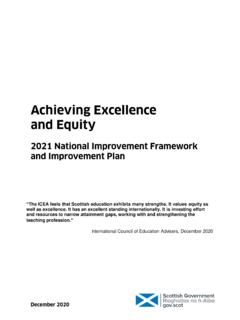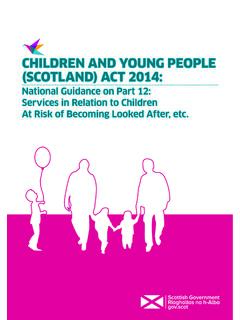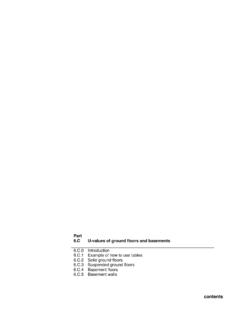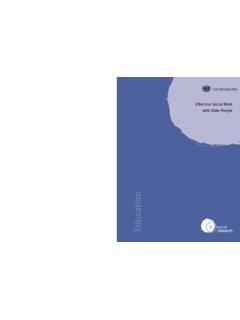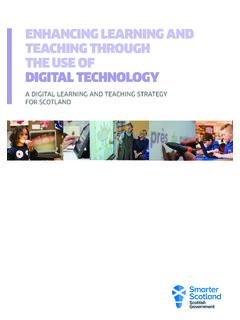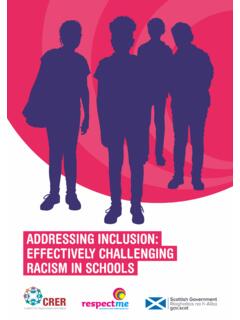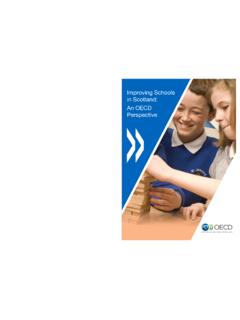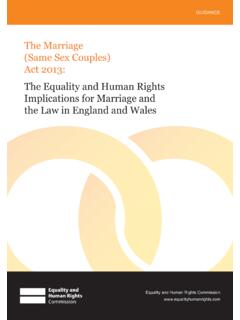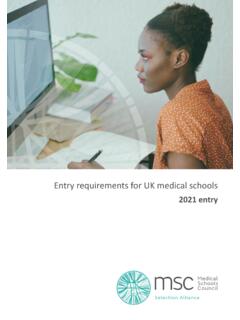Transcription of Summary Statistics Schools Scotland - Scottish Government
1 Summary Statistics for Schools in Scotland 15 December 2020 This annual statistical publication provides information on: The annual census of pupils and teachers in publicly funded Schools in Scotland , conducted on 16 September 2020 Early learning and childcare provision in Scotland , collected in the week commencing 14 September 2020 The Statistics in this bulletin supersede all previously published Statistics Supplementary data tables for early learning and childcare can be found at: Supplementary Statistics on school staff and pupils for 2020 are scheduled for publication in March 2021. Supplementary Statistics for previous years can be found at: A school information dashboard is also available: #interactivedashboards 2 3 Contents Chapter 1: Introduction.
2 4 Chapter 2: Overview .. 5 Chapter 3: school teachers .. 7 Chapter 4: Classes and pupils .. 15 Chapter 5: Early Learning and Childcare .. 20 Chapter 6: Glossary .. 25 Chapter 7: Background notes .. 28 National Statistics publication .. 28 Sources and Timing .. 28 Teachers .. 29 Classes and Pupils .. 33 Early Learning and Childcare .. 39 Corrections .. 42 Costs .. 42 Rounding and symbols .. 42 4 Chapter 1: Introduction This publication brings together information on pupils and teachers at publicly funded Schools and early learning and childcare provision. Local authorities have a duty to secure a part-time funded place (currently 600 hours a year) for three and four year olds and eligible two year olds Places are provided by local authority services, or secured through partnership arrangements with private or third sector services Early learning and childcare Pupils attend for up to six years (S1-S6)
3 Qualifications are usually taken in S4 to S6 starting at age 15-16 Secondary Schools Most children with additional support needs are educated in mainstream Schools but some with complex or specific needs are educated in special Schools Not all local authorities have special Schools In these Statistics pupils attending special Schools are not assigned to primary or secondary or to a stage Special Schools Most teachers have a four year degree including or concurrent with a teaching qualification, or have completed a Professional Graduate Diploma in Education (PGDE) following a degree Teaching graduates from a Scottish university are guaranteed a one year probationary teaching post and are referred to as induction scheme teachers in these Statistics Teachers Children usually start school between 4 and 5 years old There are seven stages from Primary 1 (P1) to Primary 7 (P7) Pupils are not streamed by ability at primary school and automatically move up a stage each year Primary Schools 5 Chapter 2: Overview The overall number of pupils and teachers both increased in 2020.
4 The pupil teacher ratio (PTR) in Schools , which gives a measure of the size of the teaching workforce relative to the pupil population, decreased to Table : Schools , pupils, teachers and PTR 2014 2015(1) 2016 2017 2018(6) 2019 2020 Schools ELC(2) 2,449 2,492 2,514 2,532 2,544 2,576 2,587 Primary 2,048 2,039 2,031 2,019 2,012 2,004 2,005 Secondary 362 361 359 360 357 358 357 Special 145 144 141 135 114 114 114 Pupils ELC(2) 101,463 97,262 96,961 95,893 96,549 96,375 90,126 Primary 385,212 391,148 396,697 400,312 400,276 398,794 393,957 Secondary 284,762 281,939 280,983 281,993 286,152 292,063 300,954 Special(3) 6,940 6,871 6,668 6,654 6,823 7,132 7,286 Total (excluding ELC)(3) 676,914 679,958 684,348 688,959 693,251 697,989 702,197 Teachers ELC(2) 1,200 1,038 985 921 821 798 729 school based 48,335 48,395 48,746 49,463 50,099 50,477 51,663 Primary 22,960 23,425 23,920 24,477 24,899 25,027 25,651 Secondary 23,401 23,059 22,957 23,150 23,317 23,522 24,077 Special 1,974 1,911 1,869 1,836 1,883 1,927 1,934 Centrally employed ( school ) 1,186 1,283 1,239 1,129 1,039 972 1,009 Total school (excluding ELC) 49,521 49,679 49,985 50,592 51,138 51,449 52,672 Total (including ELC) 50,720 50,717 50,970 51,513 51,959 52,247 53,400 Pupil Teacher Ratios Publicly funded Schools (4) Total based in Schools (5) Primary Secondary Special (1) The pupil teacher ratio for Total based in Schools in 2015 was amended in October 2017.
5 See backgroundnotes for details.(2) ELC centre count includes local authority and partnership centres, and ELC teacher figures include ELC homevisiting.(3) Special and total pupil count were updated for 2011-2016 in October 2017. See background notes for details.(4) Includes all school based and centrally employed teachers. Includes grant-aided pupils and teachers.(5) Excludes centrally employed teachers.(6) Prior to 2018, special Schools with no pupils or where no pupils were on roll but pupils from other schoolsattended were included in school counts in this table. From 2018, they have been ,126 registrations in 2,587 early learning & childcare centres (ELC) 702,197 pupils in 2,476 Schools 53,400 teachers (full-time equivalent, including ELC) pupil teacher ratio in Schools 6 The numbers of teachers increased across all sectors except early learning & childcare.
6 The decrease in primary pupils combined with the increase in primary teachers meant there were fewer pupils per teacher and consequently the primary PTR decreased to This is the lowest ever PTR for primary Schools . In secondary Schools the number of pupils grew at a faster rate than the number of teachers meaning there were more pupils per teacher, so the secondary PTR increased to This is the highest PTR in secondary Schools since 2004, when the PTR was ( Statistics pre-2014 are available from the supplementary Statistics and historical time series). 7 Chapter 3: school teachers Table : Teachers in Scotland by sector and local authority, 2020 Full Time Equivalents (FTE) Local Authority Primary Secondary Special Centrally employed Total Aberdeen City 891 751 36 48 1,725 Aberdeenshire 1,403 1,234 46 37 2,720 Angus 596 575 # 25 1,197 Argyll and Bute 425 406 8 8 846 City of Edinburgh 1,652 1,594 157 114 3,518 Clackmannanshire 291 233 27 3 554 Dumfries and Galloway 654 664 21 75 1.
7 413 Dundee City 656 593 59 31 1,340 East Ayrshire 593 545 77 18 1,233 East Dunbartonshire 589 686 51 40 1,366 East Lothian 496 485 # 27 1,008 East Renfrewshire 620 665 35 2 1,322 Falkirk 804 804 72 7 1,688 Fife 1,862 1,592 91 82 3,627 Glasgow City 2,738 2,261 307 140 5,446 Highland 1,046 1,145 43 50 2,284 Inverclyde 344 362 43 2 751 Midlothian 492 434 27 31 985 Moray 433 418 # 21 873 Na h-Eileanan Siar 150 151 # 11 312 North Ayrshire 688 634 44 45 1,412 North Lanarkshire 1,807 1,641 232 63 3,742 Orkney Islands 114 126 # 7 247 Perth and Kinross 687 626 17 16 1.
8 346 Renfrewshire 856 811 90 21 1,778 Scottish Borders 498 523 39 5 1,065 Shetland Islands 162 154 # 13 329 South Ayrshire 523 514 28 35 1,101 South Lanarkshire 1,661 1,628 150 0 3,438 Stirling 436 480 21 17 954 West Dunbartonshire 465 436 49 14 964 West Lothian 997 855 119 0 1,971 All local authorities 25,630 24,030 1,886 1,009 52,555 Grant aided 21 48 48 # 117 Scotland 25,651 24,077 1,934 1,009 52,672 52,672 teachers in Schools compared to 51,449 in 2019 (excludes ELC) pupil teacher ratio in local authority Schools 85% of teachers on the 2019/20 Teacher Induction Scheme were in employment the following school year 8 Table shows that total teacher numbers (primary, secondary, special and centrally employed) rose in each year from 2014 to 2020.
9 The number of teachers increased by 1,224 between 2019 and 2020, the biggest recorded annual increase since 1975. ( Statistics pre-2014 are available from the supplementary Statistics and historical time series). Additional teachers have been recruited in the 2020/21 school year to support the recovery of education following the disruption caused by COVID-19. These additional teachers are likely to be a major contributing factor to the increase in teacher numbers, reduction in overall PTR, decrease in average primary class sizes, increase in proportion of teachers on temporary posts and the overall proportion of the 2019/20 cohort of Teacher Induction Scheme (TIS) probationers in teaching posts. Further information on COVID-19 Education Recovery grant funded teachers, and on teachers funded through the Attainment Scotland Fund, can be found in the background notes.
10 Although the number of teachers has increased since 2019, this was not the case for each local authority. In 27 local authorities the number of teachers increased, with the largest increase of 8% seen in East Dunbartonshire; followed by Clackmannanshire and Renfrewshire, with an increase of 6%. The other five local authorities saw small decreases in teachers this year, of up to 2%. 9 Table : Teachers (all sectors excluding ELC)(1) Full Time Equivalents (FTE) Local Authority 2014 2015 2016 2017 2018 2019 2020 Aberdeen City 1,623 1,632 1,603 1,624 1,636 1,675 1,725 Aberdeenshire 2,593 2,650 2,655 2,675 2,650 2,696 2,720 Angus 1,140 1,136 1,125 1,133 1,160 1,172 1,197 Argyll and Bute 866 844 841 825 861 834 846 City of Edinburgh 3,159 3,193 3,213 3,281 3,346 3,452 3,518 Clackmannanshire 495 490 528 513 512 520 554 Dumfries and Galloway 1,481 1,479 1,466 1,470 1,436 1,436 1,413 Dundee City 1,372 1,375 1,367 1,330 1,321 1,316 1,340 East Ayrshire 1,139 1,151 1,149 1,189 1,185 1,205 1,233 East Dunbartonshire 1,191 1,204 1,217 1,245 1,248 1,269 1,366 East Lothian 902 920 913 935 960 973 1,008 East Renfrewshire 1,201 1,213 1,2

